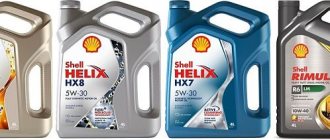What does an engine need oil for?
– protects friction surfaces from wear, jamming and other damage;
– reduces energy loss due to friction to a minimum;
– is cleaning the engine system;
– removes heat from friction surfaces;
– reduces noise and vibration of gears, reduces shock loads.
In a word, it ensures long and uninterrupted operation of the car engine.
How and when to mix oils
1. Is it possible to mix oils from the same manufacturer? Within the brand, you can mix lubricants in any proportions you like. This is due to the following:
- same base;
- identical additive elements that affect the viscosity of the petroleum product;
- using additives that do not react with each other.
Of course, the petroleum products will differ, but there will definitely not be any reaction that negatively affects the engine. It's no secret that there are manufacturing plants that produce motor oils under different brands. In this case, the same base and the same additives are used. Thanks to this, the company increases its own profit.
The characteristics of such motor oils are identical. Because of this, when mixed, they will not precipitate, curl, or foam. However, the cost of such lubricant varies significantly. Decide for yourself what is more important – brand or quality.
2. Is it allowed to mix motor oils from different manufacturers? It is allowed to mix motor oils with similar properties from different companies - additive sets in most petroleum products are similar in composition and do not react with each other. However, mix lubricants if you have a short trip ahead, for example, you urgently need to get to the nearest car service center.
3. Is it possible to mix synthetic oil with semi-synthetic oil? If you urgently need to add lubricant to an engine filled with synthetics, you can use a semi-synthetic petroleum product. 5W40 oil can be mixed with 10W40. In this case, you will get 8W40 motor oil. However, it is much better to add synthetics to semi-synthetics, for example, add 5W40 to 10W40.
4. Is it possible to mix motor oils of different viscosities? A common situation: you urgently need to top up the lubricant; the required brand of oil is available, but has a different viscosity. You can without a doubt purchase this oil and pour it into your car engine. For example, you can add 10W30 to 10W40. What will change in this case?
- same base;
- identical additive elements that affect the viscosity of the petroleum product;
- using additives that do not react with each other.
Of course, the petroleum products will differ, but there will definitely not be any reaction that negatively affects the engine. It's no secret that there are manufacturing plants that produce motor oils under different brands. In this case, the same base and the same additives are used. Thanks to this, the company increases its own profit.
5. Is it possible to mix lubricant intended for a diesel engine with motor oil for a gasoline internal combustion engine? It is necessary to talk separately about mixing fluids that are intended for different types of power units. What is the difference between a diesel engine and a gasoline engine? The operating temperature in the piston groups is completely different.
Diesel is hotter because the pressure in the combustion chambers is quite high. In view of this, diesel lubricants are designed for operation in high-temperature conditions and have a high viscosity coefficient. They also have high washing, antifriction and other characteristics. For example, diesel fuel produces a large amount of soot, which must be constantly removed.
Oils for diesel engines can be poured into gasoline engines. It is not advisable to do the opposite. Even multi-grade oils are mostly intended for older diesel engines, so you need to be careful here.
Let's summarize the indicators by which it is possible to mix oils:
- When mixing, be sure to pay attention to tolerances. They must be compatible.
- The class of motor oils must be the same. Do not put lubricant intended for trucks into your car.
- It is advisable to mix oils with the same viscosity and from the same manufacturer.
- It is necessary to increase the quality of the petroleum product. Add semi-synthetic lubricant to mineral water, and synthetic lubricant to semi-synthetic oil.
Examples
- Pour semi-synthetic oil 15W40 or 10W40 into 15W40 mineral water.
- Pour 5W40 synthetic petroleum product into 10W40 semi-synthetic oil.
- Pour 5W30 synthetic into 5W40 synthetic oil.
If there is no lubricant of better quality than the one already filled, pour in what you have, but try to fill in normal oil as soon as possible. This also applies to cases where the seller and the lubricant do not inspire confidence. When producing counterfeits, API and ACEA standards are ignored.
Reduce the quality of lubricant. Do not add semi-synthetic petroleum products to synthetics.
- Mixing mineral water with synthetics. This is due to a noticeable deterioration in the properties of the lubricating fluid. Mineral water is less viscous than synthetics (not to be confused with SAE viscosity).
- The SAE indicator reflects the ability of oils not to change their own viscosity in a certain temperature range. The larger it is, the better the oil performs its task. This is of great importance for modern engines with a turbine and high speeds.
- Don't mix fifty-fifty. It is recommended to add a volume of oil not exceeding fifteen percent of the volume of liquid already filled.
Seal
In what proportion should you mix the oil?
When two different products are taken, the final viscosity depends on the proportions taken. In order not to harm the engine, you should dose the oil correctly. It is recommended to add lubricant in small quantities, the optimal ratio is 1:1. If you mix 10W40 and 5W40 in equal proportions, the average performance will be achieved - 8W40. But you can also get 6W40 by changing the ratio of the components.
If a replacement is made, the oil residue that cannot be drained is on average 10 percent. Although the new lubricant does not mix with the old one, they both come into contact with the flushing oil. In this case, we mean a ratio of 9:1. No dangerous reactions between the components are observed.
Some car enthusiasts try to improve the quality of the oil on their own by adding synthetics to semi-synthetics. If you add 5W40 liquid to 10W40 lubricant, nothing bad will happen, and the addition should be no more than a quarter of the total volume. But adding 10W40 oil to a tank with 5W40 is not recommended.
Additives
Additives added to motor oil to improve performance have completely different chemical compositions.
In this case, when mixing one mixture with another, you can get a mixture that is quite “explosive” for the engine. For example, additives found in mineral lubricating fluid are responsible for maintaining stable viscosity. Which is absolutely unnecessary for “synthetics”, which already have sufficient viscosity for it.
And this property once again proves that, when interacting, mineral and synthetic lubricant additives will not only worsen the performance of the vehicle’s power plant, but will also completely disable it. Also, taking into account all of the above, we can come to the conclusion that “semi-synthetics” should not be mixed with any of the oils either.
The problem when mixing oils may not be the base itself, but the chemical reaction between additives from one and another group of motor oils.
Why does it matter what kind of oil to add to the engine?
The first rule that should be followed in this situation is that any motor oil is better than none. In other words, if, in such an emergency, you get to a seedy auto parts store and find a meager selection of lubricants there, fill in any oil and move towards the nearest car service center, where the oil will be drained and the engine washed.
The risk that additives of different types will enter into a chemical reaction that will destroy rubber seals, lead to the development of corrosion and coking, will be greater the greater the amount of “foreign” oil you add. As a rule, adding no more than 10% is safe and should not lead to loss of properties. However, we repeat, when working “dry” the consequences will be even more dire.
But what to do if there is a choice of oils in a store or at a service station, but the product of the exact specification that was used previously is not available? In this case, try to find oil from the same manufacturer that was previously poured into the engine of your car.
The fact is that different models of the same brand have common basic elements and similar additives, unlike analogues of other brands. At the same time, it is clear that, if possible, you need to pour synthetics into synthetics, semi-synthetics into semi-synthetics, and mineral water into mineral water. In extreme cases, the viscosity requirements can be neglected, especially if the topping dose is small. For example, you can allow mixing mobil 5W30 and mobil 10w40 oils.
Also try to focus on the API (American) and ACEA (European) standards (indices). Each of these standards provides for mixing oils from different manufacturers, which means there is a high chance that chemical reactions dangerous to the power plant (sedimentation, foaming effect, etc.) will not occur.
At the same time, when choosing an API standard oil for a passenger car engine, take fluids of at least classes SN or SM (modern cars). Also within the API index there are universal oils (for diesel and gasoline power plants). These types are labeled, for example, SJ/SF, SF/CC, SG/CD and others. The European ACEA index, in turn, includes three classes of automotive motor oils - A (gasoline engines), B (diesel engines), E (diesels for high-power car engines).
There are other useful rules that will help you save your engine during emergency topping up of lubricants. So, the class of oil that you add must match the one that is already in the engine. Namely, do not add oil intended for trucks to the engine of a passenger car. Mixing motor products and transmission products is also strictly prohibited.
If possible, mix oils of the same viscosity. Also try to improve the quality of the oil - add semi-synthetic to mineral oil, and synthetic to semi-synthetic oil. On the contrary (lowering the quality of the oil), for example, by pouring mineral water into semi-synthetics and synthetics, is highly not recommended. To ensure the required degree of viscosity if it is impossible to find an analog oil, fill in mineral 15w40 with semi-synthetic 15w40 or semi-synthetic 10w40. You can add 5w40 synthetic to 10w40 semi-synthetic, 5w30 synthetic to 5w40 semi-synthetic, etc. In this case, again, be guided by the tolerances and standards described above.
It is clear that after adding substandard oil to the engine, you need to get to the repair site, followed by flushing the power unit and completely replacing the lubricant with the one recommended by the car manufacturer. It is also necessary to change the filter elements, and reduce the service interval until the next replacement by half.
The main harm comes from additives
If only mineral and synthetic oil bases were mixed, then, perhaps, much less damage would be caused to the engine than what is produced by the different chemical composition additives found in these oils. The fact is that not all additives contained in mineral oil dissolve in the synthetic base.
Just as not all “synthetic” additives can dissolve in the mineral oil base. No one can predict what can happen in each individual case of mixing such oils. One thing is certain - the engine will be ill from such a “cocktail”. It’s bad, first of all, from the elements of the additives of the oil that were added – it doesn’t matter whether it’s mineral or synthetic – that have precipitated into an insoluble precipitate.
This undissolved sediment can form a viscous mixture that will clog the oil receiver grids and oil channels, causing the engine to experience oil starvation.
Operating in this mode, even for a short period of time, can lead to failure of the unit. It must be remembered that oil of a certain composition (mineral or synthetic) forms chemically modified layers and adsorbed films on the rubbing surfaces of engine parts. When other additives are added, these layers are destroyed, and wear of parts increases, which also significantly harms the engine.
Types of modern motor oils
Oils produced today for car engines include 2 components - a base fluid and an additive package. The base oil occupies at least eighty percent of the volume. Additive elements can occupy no more than twenty percent of the total volume of the lubricant. The base fluid can be mineral, semi-synthetic, or synthetic. Additive packages may vary, but not too significantly.
There are 4 types of motor oils, each of which includes a base fluid and an additive package. Additives add special properties to the oil.
- Mineral. Produced from petroleum through selective purification. During manufacturing, paraffins are separated and hydrotreated. This creates a foundation. Mineral oil costs less than synthetics and semi-synthetics.
- Synthetic. Manufactured through chemical synthesis. As a result of synthesis, hydrocarbon molecules of the same size are formed. The process is very complicated, which is why such lubricants are more expensive than others.
- Semi-synthetic. They combine an artificial product with a mineral one. The price of semi-synthetics is higher than that of mineral lubricants, but lower than that of synthetics.
- Hydrocracking. An intermediate option between synthetic and semi-synthetic motor oils. These are mineral lubricants that have been treated with the hydrocracking method. In terms of cost, such a lubricant is cheaper than a synthetic one.
There are no officially established prohibitions or permits for mixing oils that belong to different categories/brands. There are only certain recommendations in this regard.
In the production of oils, there are general standards that all manufactured lubricants must comply with. In North America, API requirements apply; in Europe, ACEA requirements apply.
They contain a general requirement that resolves the issue of the admissibility of mixing lubricants. This paragraph states that lubricant manufacturers must guarantee full compatibility of their own oils with petroleum products from other companies in order to sell their products. Consequently, absolutely all motor oils can be mixed without fear that a reaction will begin and the oil will crystallize, which will lead to engine damage.
The above information can be easily verified. In view of this, discussions about a global conspiracy of car oil manufacturers who specifically use various additive components that are not compatible with each other are completely meaningless.
note
Although all lubricants can be mixed with each other, this does not mean that it is possible to mix without any restrictions and it is not recommended to do so regularly. It is necessary to follow the instructions of the machine manufacturer and fill it with engine oil, which is specified in the technical documents. This will ensure long-term operation of the motor without failures or the need for repairs.
They contain a general requirement that resolves the issue of the admissibility of mixing lubricants. This paragraph states that lubricant manufacturers must guarantee full compatibility of their own oils with petroleum products from other companies in order to sell their products. Consequently, absolutely all motor oils can be mixed without fear that a reaction will begin and the oil will crystallize, which will lead to engine damage.
There are only four of them and each of them includes a base and a package of additives that give the product certain properties.
- Mineral motor oils. Made from selectively refined petroleum. During production, paraffins are separated, hydrotreated, and the result is a base. Mineral compositions have the lowest cost.
- Synthetics. Produced by chemical synthesis. The result is hydrocarbon molecules with the same size. This process is complex, so this material is the most expensive.
- Semi-synthetic. A mixture of an artificial product and a mineral product in a certain ratio. It is more expensive than mineral compounds, but cheaper than synthetic ones.
- Hydrocracking. Something “in between” synthetics and semi-synthetics. Essentially, these are mineral oils that have undergone deep processing - hydrocracking. In terms of price, such a product is inferior to “pure” synthetics.
The situation is not uncommon: when you urgently need to add oil, there is a product from the same manufacturer, but the viscosity is different. You can safely buy lubricant and add it to the engine of a VAZ or a car of any other brand. For example, add 10W30 to 10W-40. What will change in this case? There will definitely be no conflict between the components of the composition, because...
the same manufacturer uses the same additives. It’s just that the liquid in the power unit will become a little more fluid. The engine will start at temperatures down to minus 35 degrees. A negative point can only appear when the engine is operating at a critically high temperature, which should not be allowed in any case.
What is better - a synthetic or mineral product?
Which oil is better?
To answer this question, it is necessary to take into account certain factors and remember how one type of lubricant differs from another.
Synthetic oil has good fluidity
First of all, check the car manufacturer's recommendations. Read the owner's manual that came with your car. It indicates which car oil should be poured in the summer and which in the winter season. The optimal viscosity of the lubricant is also specified there.
Also take into account the degree of engine wear and the type of oil fluid that was previously filled. For example, if you poured mineral water into the internal combustion engine for a long time, then the cracks that appeared in the rubber were filled with deposits.
If you pour synthetics into such a power unit, it, due to its own leaching and acidity characteristics, will remove everything, including the necessary deposits. That is why situations often happen when, when replacing mineral motor oil with synthetic oil, the latter pours out of the engine through cracks.
Experts advise using a synthetic product in new engines that are operated in harsh conditions (for example, in sports cars). If you have an old car, you simply need to change the oil more often.
What to do if you do mix mineral oil with synthetic oil
First of all, don’t panic. And try to get to the nearest service station as soon as possible, preferably in a gentle mode (without stress). Where they will diagnose your engine and determine whether you will need to flush the oil system, or you can get by with simply replacing the oil and oil filter.
PS To be fair, it is worth saying that adding mineral oil to synthetic oil and vice versa without causing serious damage to the engine is still possible. But only if you have added oil from the same manufacturer and are going to drive this “mixture” for a short time. Ideally, to the nearest service station. But even in this case, changing the oil and filter cannot be avoided.
Conclusion
For me personally, the general conclusion on the question of whether it is possible to mix motor oils from different manufacturers is that it is possible, but not necessary, at least not unless absolutely necessary. That is, if you are making a routine replacement of a lubricant, it is better to pour a high-quality lubricant provided by the manufacturer, and not engage in collective farming and create cocktails, from which the health of the engine may suffer.
I believe that mixing is acceptable during emergency stops:
- It leaked far from civilization, and in the trunk there is a canister with another
- The level of lubricant dropped sharply on a deserted road, while the car has a spare one, but from a different manufacturer and brand
- Perhaps some other not very standard situations
In all other cases, it is better not to deal with chemicals and take care of your car.
Risks and consequences
The consequences of mixing different oils depend on which mixtures and from which manufacturers were used. By giving preference to one proven brand or the one that was originally used in the car, you don’t have to worry about the engine’s performance.
The use of motor oils from different manufacturers, which differ in viscosity and chemical formula in general, can lead to problems. If incompatible substances are mixed once, the motor will work intermittently, but only for the first time.
As a result of repeated experiments with oil, deposits will begin to form in engines, which will lead to its wear. They gradually shorten its service life, and if the driver does not care at all about what mixtures are poured into the engine, they cause a sudden breakdown.
"Lukoil Lux SN/CF 5W-40"
Synthetic, all-season. Belongs to the premium class.
Purpose:
- vehicles running on diesel fuel;
- supercharged gasoline engines that are installed in cars, minibuses and trucks.
Domestic oil "Lukoil Lux SN/CF 5W-40" is synthetic. Judging by reviews from car enthusiasts and tests, this is by far one of the most reliable lubricants in its price category.
It is an officially registered Russian product. Provides the maximum level of protection and meets all necessary technical specifications.
- prevents the formation of lime deposits in the cylinder and piston at high temperatures;
- prevents sludge formation at low temperatures;
- has a beneficial effect on seals;
- The chemical composition of the oil makes it easier to start the engine in extreme conditions.
The formation of a protective film on the parts provides maximum protection when starting the engine.
Advantages of Lukoil Lux SN/CF 5W-40:
- reduces fuel consumption;
- minimizes the presence of noise;
- is the best engine protection in all conditions;
- prevents the formation of deposits on the engine.
The basis
Based on the above classification, there are two bases for the oil, as well as a derivative obtained by mixing them - “semi-synthetic”. It turns out that the mixture is created at the production level. But this mixture is made from the basics.
It turns out that synthetic and mineral bases mix well with each other. Moreover, the production of foundations has now been established, which are designated as synthetic, but in their composition a part of the mineral base is added during production.
The bottom line is that if oils consisted only of bases, there would be no problems with mixing at all. It would be possible to mix oils of different categories and in different proportions without any harm to the car.
Is it possible to mix mineral water and semi-synthetics?
from
Evgeny 10.10.2019, 17:47 updated 10.12.2019, 18:03 3k P G Comments
Is it possible to mix mineral water and semi-synthetics? What will come of this and will it harm the engine?
First, answer us: why? Why do you need to mix anything at all? There is native oil, there are recommendations from the car plant. Why do we need to reinvent the wheel? Manufacturers clearly know their cars better than we do and have selected oils for them that best suit the specifics of a particular engine.
Although we will not deny there are situations when you have to mix oils. For example:
- When the oil level has dropped, it is impossible to buy original oil, but you still need to drive.
- When you decide to switch from one type of oil to another (after all, no matter how carefully you drain the old oil, 8 - 10% will still remain in the engine).
Composition and classification of oils
Motor oil, depending on the main composition, is divided into 4 types: mineral, semi-synthetic, hydrocracking and synthetic. All of them have different additives, different viscosity values, according to the international SAE classifier. The job of every motor oil is to create a thin film between the contacting surfaces of parts in the engine to minimize friction between them.
The basis
Each oil substance that lubricates engine parts consists of two main components - a base, or base composition, as well as a package of additives that give the oil its basic qualities, enhancing and improving the effect of the base composition.
- Mineral oil is obtained from petroleum using a selective purification method. In this case, the removal of paraffins from the composition (dewaxing) is carried out as much as possible. Next, hydroprocessing is carried out, the output of which is a mineral base.
- Synthetic - a chemical synthesis method is used to form the base of this oil. The goal is to obtain chains of hydrocarbon molecules of the same length and size from light hydrocarbons. The method is quite complex and expensive. Therefore, synthetic oils are the most expensive.
- Hydrocracking is a special category of oils that a large number of manufacturers position as synthetic. In fact, these are mineral compounds that are maximally purified using the deep hydrocracking method. In terms of their qualities, they are close to synthetics. Many manufacturers offer them as semi-synthetic oil formulations. Of course, they are cheaper than real synthetic fluids.
- Semi-synthetic is a lubricant whose base is a mixture of a mineral component to which synthetics are added, maintaining a certain proportion.
Depending on the base, each oil has its own characteristics and properties. Mineral oil is characterized by:
- budget price, availability;
- environmental cleanliness, since chemical compounds are minimally represented here;
- versatility in use.
Synthetic formulations are best suited for the qualities that a motor oil must have. Their advantages:
- viscosity changes little over a wide temperature range - from negative to high;
- low volatility and good fluidity;
- high resistance to oxidation;
- Fewer additives are required.
Semi-synthetics have the following features:
- relatively low cost, only mineral compositions are cheaper;
- applies to any types of internal combustion engines;
- prevents the formation of limescale on parts;
- has low volatility.
Viscosity
All types of oils from different manufacturers are characterized by their viscosity index. According to the most common viscosity classifier - SAE - oils are divided into summer, winter and all-season. According to the standard, there are 6 winter and 6 summer oils. Since in our climate zones the temperature range throughout the year is quite large, only all-season oils are used.
The second digit after W (40) determines the viscosity of the oil composition at engine operating temperatures. It is measured at 100 and 150°C, although there are places in the engine where this temperature is much higher. For example, in the cylinder-piston group. If we take, for example, lubricant compositions 0W30, 5W30 and 10W-40, we get the following picture:
- 0W30 and 5W30 have the same level of high-temperature viscosity, but retain their properties at different negative temperatures: -35 and -30°C, respectively.
- 10W-40 can operate down to a lower limit of -25°C, and at high temperatures it is thicker than the above lubricants. 40 has a stronger film between rubbing surfaces than 30.
One of the riskiest options is to mix mineral water with synthetics or vice versa. These oils have different bases, so a conflict of chemical components cannot be avoided. Many “experimenters” are trying to obtain inexpensive semi-synthetics in this way. Consequences:
- rapid coking of piston rings and slagging of the engine: this means clogging of oil passages and channels with chemical reaction products;
- the appearance of sediment and loss of basic properties of the lubricant composition.
If you mix mineral oil with synthetics, foam will form. Already after 500 km of run, a precipitate will form - whitish flakes. And after 1000 km the mixture begins to thicken and clog the oil channels. The result of the “experiment” will be engine failure and, as a consequence, its overhaul. What can happen if you mix the ingredients incorrectly is described in the video below.
Is it possible to mix Mineral and Synthetic motor oil?
The question is no longer new, but car enthusiasts still do not have a common opinion.
There is still a myth that if you mix synthetics and mineral oil, the mixture will definitely foam or sediment will form. Is it really? I am sure that many of those reading this material are convinced from their own experience that this judgment is fundamentally wrong. Let's figure out what types of oils exist and how they differ. There are three types of motor oils used in internal combustion engines
Mineral product of petroleum distillation
Semi-synthetic is a mixture of synthetic and mineral oils, sometimes simply mineral oil purified by hydrocracking.
Synthetic is an oil synthesized under certain conditions from hydrocarbon raw materials, that is, from some hydrocarbon chains, others are made using a chemical reaction, which.
In addition to the base, a package of additives is added to each type of oil.
The very existence of semi-synthetic oil in the form of a mixture of mineral water and synthetics makes mixing different bases a reality. As for additives, it’s even easier. From open sources on the Internet, it became clear that most oil additives are produced for use with any of the three base oils.
Based on this, mixing absolutely any oils becomes possible.
From my experience, I can say that semi-synthetic oils Gazpromneft, Lukoil, Shell, Elf, Mobil were mixed without any consequences, before adding another oil, I conducted an experiment with the remaining oil that was in the engine, the mixture did not react in any way, no sediment formed, nothing became cloudy. The engine worked the same as before.
It is not recommended, but it is permissible to mix oils with different viscosities and API tolerances. The operating modes of the oil at certain temperatures and its purity and ability to form deposits depend on these indicators.
If the question is to add mineral water to synthetics or drive with a low level, it is always better to add any oil that is at hand. This will cause less harm to the engine.
A couple of clicks on the ad below will help develop the channel.
Source









